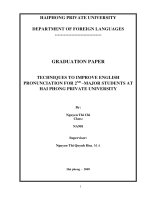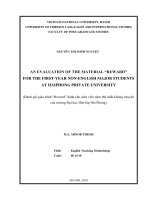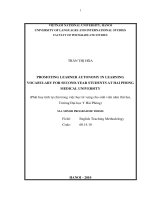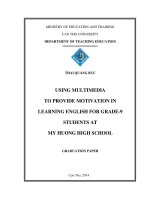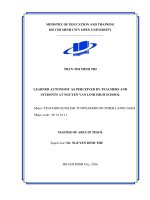Promoting learner autonomy in learning vocabulary for second-year students at Hai Phong Medical University
Bạn đang xem bản rút gọn của tài liệu. Xem và tải ngay bản đầy đủ của tài liệu tại đây (247.42 KB, 14 trang )
Promoting learner autonomy in learning
vocabulary for second-year students at Hai
Phong Medical University
Trần Thị Hòa
Trường Đại học Ngoại Ngữ
Luận văn ThS. Chuyên ngành: English Linguistics; Mã số: 60 22 15
Người hướng dẫn: M.Ed. Phùng Hà Thanh
Năm bảo vệ: 2010
Abstract: Learner autonomy has been widely promoted by researchers and educators
worldwide because of its benefits to learners. However, a review of the literature shows that
there is still a lack of insights into how learner autonomy is practiced and can be developed in
the context of Vietnam. This study is intended as an action research to improve the
vocabulary learning practice of the second-year English non-majors at Hai Phong Medical
University by means of an explicit strategy training programme of three strategy sets, namely
dictionary-related strategies, recording vocabulary and studying affixes. A ten-week strategy
training programme, which was divided into three phases, was designed for a class of 27
students. In the first phase, pre-treatment questionnaires were used to study the students’
problems in learning vocabulary. Then the students attended three strategy teaching lessons.
In the second phase, which focuses on the students’ performance and participation in the use
of the taught strategies, the students kept word-learning records as guided vocabulary
practice. In the last phase, they practiced vocabulary self-study in a free-style diary. By the
end of the last phase, post-treatment questionnaires were distributed. The last phase aims at
measuring the extent of maintenance of the taught strategies in the students’ independent
learning and at disclosing their perception of the strategy training programme. The results
from the action research showed that (1) the learners’ biggest difficulty in learning
vocabulary was “not knowing how to learn”; (2) they displayed good performance of all the
three strategy sets; (3) two-thirds of them exhibited satisfactory participation in using these
trained strategies; (4) the strategy sets of using dictionaries and recording vocabulary are
much better maintained than the strategy of studying affixes. As regards their perception of
strategy training, the students assessed dictionary-related strategies as the most useful and
most frequently-used, then recording vocabulary strategy came second, and the last position
was for studying affixes. The strategy training programme was appreciated as being highly
effective. The study will hopefully contribute to the literature of learner autonomy by
showing an example of how it can be developed in an Asian educational setting.
Keywords: Tiếng Anh; Phương pháp dạy học; Từ vựng
6
Content:
TABLE OF CONTENTS
TABLE OF CONTENTS PAGE
Declaration i
Acknowledgement ii
Abstract iii
List of tables and figures viii
PART A: INTRODUCTION
1. Rationale of the study 1
2. Aims and objectives of the study 2
3. Scope of the study 3
4. Methods of the study 3
5. Significance of the study 4
6. Overview of the study 4
PART B: DEVELOPMENT
CHAPTER 1: LITERATURE REVIEW
1. Vocabulary 5
1.1. Definition of vocabulary 5
1.2. Processes of vocabulary acquisition 5
2. Vocabulary learning and teaching 7
2.1. Aspects of learning a word 7
2.2. Explicit approach vs. Incidental learning approach 8
3. Learner autonomy 10
3.1. Definition of autonomy 10
7
3.2. Principles of developing autonomy 12
4. Vocabulary learning strategies 14
4.1. Definition of learning strategies 14
4.2. Classification of vocabulary learning strategies 15
4.3. Frameworks for strategy training 16
CHAPTER 2: METHODOLOGY
1. Background of the study 18
1.1. Current learning and teaching of English at Hai Phong
Medical University 18
1.2. Identification of the problem 18
2. Participants 19
3. Implementation of the action research 19
4. Instruments of data collection 22
4.1. Description of the pre-treatment questionnaire 22
4.2. Description of the vocabulary – learning records 23
4.3. Description of the vocabulary learning diary 24
4.4. Description of the post – treatment questionnaire 26
5. Data collection procedures 26
6. Data analysis procedures 26
CHAPTER 3: RESULTS AND DISCUSSION
1. Phase One - Research question 1: Students’ problems in independent
vocabulary learning 28
2. Phase Two 29
8
2.1. Research question 2: Students’ performance in the use of the taught
strategies 29
2.1.1. Students’ performance in the use of Strategy Set 1 and Set 2 29
2.1.2. Students’ performance in the use of Strategy Set 3 30
2.2. Research question 3: Students’ participation in the use of the taught
strategies 31
2.2.1. Students’ participation in the use of Strategy Set 1 and Set 2 31
2.2.2. Students’ participation in the use of Strategy Set 3 32
3. Phase Three 32
3.1. Research question 4: Students’ maintenance of the taught strategies
in independent vocabulary learning 33
3.2. Research question 5: Students’ perception of the effectiveness of
the strategy training programme 34
3.2.1. Students’ frequency of using the taught strategies before and
after the training programme 34
3.2.2. Usefulness of the taught strategies 35
3.2.3. Students’ evaluation of the strategy training programme 36
PART C: CONCLUSION
1. Conclusion 39
2. Pedagogical implications from the findings 40
3. Limitations of the study and suggestions for further study 40
REFERENCES 41
9
APPENDICES
Appendix 1: Schmitt’s taxonomy of vocabulary learning strategies (1997) I
Appendix 2: Three lesson plans III
Appendix 3: Three word-learning records XXIV
Appendix 4: Sample vocabulary-learning diaries XXXIII
Appendix 5: Pre-treatment questionnaire survey (English version) LVIII
Appendix 6: Pre-treatment questionnaire survey (Vietnamese version) LX
Appendix 7: Post-treatment questionnaire survey (English version) LXII
Appendix 8: Post-treatment questionnaire survey (Vietnamese version) LXV
10
LIST OF TABLES AND FIGURES
TABLES PAGE
Table 1: Criteria for evaluating word-learning records 24
Table 2: Holistic rubric for marking the maintenance of the trained strategy sets 25
Table 3: Students’ performance in the use of Dictionary-related strategies and
Vocabulary-recording strategies 29
Table 4: Students’ performance in the use of Affix-studying strategies 30
Table 5: Students’ participation in the use of Dictionary-related strategies and
Vocabulary-recording strategies 31
Table 6: Students’ participation in the use of Affix - studying strategies 32
FIGURES
Figure 1: Students’ problems in independent vocabulary learning 28
Figure 2: Students’ maintenance of the taught strategies in independent
vocabulary learning 33
Figure 3: Frequency of vocabulary strategy use before and after training 34
Figure 4: Usefulness of the taught strategies 35
Figure 5: Effectiveness of the strategy training programme 36
Figure 6: Students’ recommendations for vocabulary-learning strategy training 38
11
PART A: INTRODUCTION
1. Rationale of the study
Learner autonomy, a concept promoted by Holec (1981) and others in the context
of European language education, has become a favorite topic for analysis for the last
twenty years. In many parts of the world, learner autonomy has been put forward as a goal
to achieve (Pemberton et al., 1996; Sinclair et al., 2000; Little et al., 2000; Benson, 2001).
Several arguments may be used in favor of developing autonomy in language learners. For
example, according to Naimen et al. (1978), autonomous learning is more effective than
other approaches to learning, and Waite (1994) specifies that learners need to take charge
of their own learning in order to make the most of available resources, especially outside
the classroom.
Despite being widely discussed worldwide, learner autonomy remains a fairly
novel concept in Vietnam. Whether or to what extent learner autonomy is developed and
practiced in Vietnamese schools and universities is still open to question. Furthermore,
since the idea of learner autonomy originated from Western cultures, it hardly suffices to
just transfer the concept to an Asian context (Benson, Chik & Lim, 2003; Smith, 2003).
Rather, the implementation of learner autonomy in Asian countries should be tailored so
that an appropriate methodology for developing learner autonomy in non-Western contexts
can be devised (Smith, 2003). Another argument is that learner autonomy is a universal
social phenomenon, which manifests itself differently in different local contexts (Holliday,
2003). Because of all these complex and interesting points, it seems appealing to explore
how autonomy can be enhanced in an Asian educational institution like Hai Phong Medical
University. Moreover, developing learners’ autonomy becomes increasingly important as
far as tertiary education is concerned. A student at university is required to do a substantial
amount of research for his assignments, so he is supposed to know when and how to work
independently so that he can achieve a satisfactory result.
Specifically, the local context of Hai Phong Medical University calls for the idea of
promoting learner autonomy. The second-year students, who are at pre-intermediate level,
do not seem to study English as well as in the first year. Having taught them for three
successive semesters, I immediately take notice of the situation and intend to design a
remedy plan to improve it. After my open talk with the whole class, several problems came
12
to light. Most of the students feel discouraged by a large number of words they encounter
in each English lesson. As many of them confess, learning vocabulary seems to be the
most difficult and most important to them. However, as English non-majors, the students
have only four periods per week for English lessons. It means the time spent on vocabulary
learning is really limited in class. In order to develop the students’ vocabulary, it is crucial
that they practice independent vocabulary learning regularly outside class. Therefore, it has
become increasingly essential to provide them with useful learning strategies so that they
can employ in their self-study time. In this case, the success of learning vocabulary
depends very much on how effectively and autonomously the students practice vocabulary
self-study. As Waite (1994) says, learners need to take charge of their own learning in
order to make the most of available resources, especially outside the classroom.
For all the reasons above, I have decided to undertake a study on promoting
learner autonomy in learning vocabulary for second-year students at Hai Phong
Medical University. The focus of the study is a training programme of vocabulary –
learning strategies conducted for ten weeks.
2. Aims and objectives of the study
Firstly, the study aims at improving the students’ autonomous vocabulary learning
by teaching them some helpful strategies, namely dictionary-related strategies, recording
vocabulary and studying affixes. Secondly, it is intended to evaluate their employment of
these vocabulary-learning strategies in terms of performance, participation and
maintenance. These aims can be achieved by answering the following research questions:
1. What are the problems that the students encounter in their independent
vocabulary learning?
2. How well do the students use the taught strategies in their guided vocabulary
practice?
3. How much do the students use the taught strategies in their guided vocabulary
practice?
4. To what extent do the students maintain the taught strategies in their
independent vocabulary learning?
5. How effective is the strategy training programme in helping the students learn
vocabulary, as perceived by the students?
13
3. Scope of the study
The research focuses on one specific way of developing learner autonomy: the
explicit teaching of learning strategies. A vocabulary-learning strategy training programme
is conducted for ten weeks. Within the scope of the study, only three strategy sets, namely
dictionary-related strategies, recording vocabulary and studying affixes, are taught. The
effectiveness of the taught strategies is measured in terms of performance, participation
and maintenance. Performance refers to the extent of correctness when the students use the
taught strategies while participation means how much they use these strategies in their
guided vocabulary practice. Lastly, maintenance refers to the extent of retaining the taught
strategies in their independent vocabulary study.
The participants include 27 second-year students of the same English class at Hai
Phong Medical University and their teacher. In this study, the teacher is in charge of
teaching the class and plays the role of the researcher at the same time.
4. Methods of the study
The current study is carried out as an action research, which combines qualitative
and quantitative approaches. The action actually taken is a vocabulary-learning strategy
training programme designed for the duration of ten weeks. The programme is divided into
three phases.
In phase one, pre-treatment questionnaires are distributed to seek the answer for
research question one regarding the students’ problem in learning vocabulary. Then, the
students are taught about three strategy sets, namely dictionary-related strategies,
vocabulary-recording and affix-studying.
In phase two, three word-learning records are provided as guided practice of the
taught strategies. The data from the word-records aim at answering the research question
two and three about the students’ performance and participation in the use of the taught
strategies.
In phase three, the students keep free-style vocabulary learning diaries, in which
they record the vocabulary they want to learn in their self-study time. The diaries are used
to answer the research question four about the extent of maintaining the taught strategies in
the students’ independent vocabulary learning. By the end of phase three, post-treatment
questionnaires are distributed to answer the research question five about the learners’
perception of the strategy training programme.
14
The data from the pre-treatment and post-treatment questionnaires, the word-
learning records and vocabulary-learning diaries are calculated with regard to items’
frequency, mean, and percentage.
5. Significance of the study
First and foremost, the habit of independent vocabulary learning will hopefully be
developed for the second-year students at Hai Phong Medical University. The students can
overcome their difficulties in learning vocabulary by means of monitoring and regulating
their self-study with appropriate learning strategies. In this way, the researcher hopes that
the students’ awareness of learning strategies and learner autonomy can be raised and
nurtured.
Second, the study offers an example of how learner autonomy can be fostered in an
Asian context. It is expected that the study will contribute an insightful picture of the
practice of Asian learner autonomy to the literature and help to shed light on the concept of
learner autonomy.
6. Overview of the study
The research paper consists of the following parts:
Part A. Introduction
Part B. Development
The development is divided into three chapters:
Chapter one (Literature review) provides the theoretical background of the
study, covering the key terms and review of related studies.
Chapter two (Methodology) justifies and describes the methodology of the
study in details.
Chapter three (Results and discussion) presents full analysis of the collected
data and discusses the findings.
Part C. Conclusion
51
REFERENCES
Beckman, P. (2006). Strategy Instruction. Retrieved January 21, 2010, from
Benson, P. (2001). Teaching and researching autonomy in language learning. Harrow,
England: Pearson Education Limited.
Benson, P., Chik, A. & Lim, H.Y. (2003). Becoming autonomous in an Asian context:
Autonomy as a sociocultural process. In D. Panfreyman & R. C. Smith (Eds.),
Learner autonomy across cultures. (pp. 23-40). New York: Palgrave Macmillan.
Burns, R.B. (2000). Introduction to research methods. London: SAGE Publications.
Carr, W. & Kemmis, S. (1983). Becoming critical: knowing through action research.
Victoria: Deakin University Press.
Chapelle, C. A. (1994). Are C-tests valid measures for L2 vocabulary research? Second
Language Research, 10(2): 157–187.
Cohen, A. D. (1998). Strategies in learning and using a second language. England:
Addison Wesley Longman Limited.
Cohen, L. & Manion, L. (1985). Research methods in education. London: Croom Helm.
Dickinson, L. (1987). Self-Instruction in Language Learning. Cambridge: Cambridge
University Press.
Ellis, N. C. (1995). The psychology of foreign language vocabulary acquisition:
Implications for CALL. Computer Assisted Language Learning, 8,2-3:103–128.
Finegan, E. (2004). Language: Its structure and use. United States of America: Wadsworth
Thomson
Gu, Y & Johnson, R.K. (1996). Vocabulary learning strategies and language learning.
Language learning, 46: 643-679.
Harmer, J. (1991). The practice of English language teaching. Great Britain: Longman.
Holec, H. (1981). Autonomy and foreign language learning. Oxford: Pergamon.
Holliday, A. (2003). Social autonomy: Addressing the dangers of culturism in TESOL. In
D. Panfreyman & R. C. Smith (Eds.), Learner autonomy across cultures. (pp. 110-
126). New York: Palgrave Macmillan.
Hulstijn, J. H., Hollander, M. & Greidanus, T. (1996). Incidental vocabulary learning by
advanced foreign language students: The influence of marginal glosses, dictionary
52
use, and occurrence of unknown words. The Modern Language Journal, 80,iii:
327–339.
Krashen, S. D. (1989). We acquire vocabulary and spelling by reading: Additional
evidence for the input hypothesis. The Modern Language Journal, 73: 440–464.
Little, D. & Dam, L. (1998). Learner autonomy: What and why? Retrieved October 10,
2009 from littledam.html
Little, D. (1991). Learner autonomy: Definitions, issues and problems. Dublin
Little, D., Dam, L., and Timmer, J. (eds) (2000). Focus on learning rather than teaching:
Why and how? Dublin: Trinity College, Centre for language and communication
studies.
Mayer, R. (1988). Learning strategies: An overview. In C. Weinstein, E. Goetz & P.
Alexander (Eds.), Learning and Study Strategies: Issues in assessment, instruction,
and evaluation. (pp. 11-22). New York: Academic Press.
McCarthy, M. (1990). Vocabulary. Hong Kong: Oxford University Press.
Merriam-Webster online dictionary. Retrieved October 28, 2009, from
Naiman, N., Frohlich, M., Stern, H.H. and Todesco, A. (1978). The good language learner.
Toronto: Ontario Institute for Studies in Education.
Nation, I. S. P (1990). Teaching and learning vocabulary. Boston: Heinle & Heinle.
Nation, P. (2001). Learning vocabulary in another language. Cambridge: Cambridge
University Press.
Nguyen, T. N. (2007). Developing English vocabulary for the 10th form students at high
school for gifted students at Hanoi National University of Education. Minor
Thesis. Hanoi: Vietnam National University.
Nunan, D. (2000). Autonomy in language learning. Retrieved November 20th, 2009 from
o/presentations/autonomy_lang_learn.pdf
O’ Malley, J. M. & Chamot A. U. (1990). Learning strategies in second language
acquisition. Cambridge: Cambridge University Press.
Oxford, R. L. (1990). Language learning strategies: What every teacher should know.
New York: Newbury House.
Palfreyman, D. (2003). Introduction: Culture and learner autonomy. In P. David & C. S.
Richard (Eds.), Learner autonomy across cultures. (pp. 1-19). Great Britain:
53
Palgrave Macmillan.
Pemberton, R., Li, E.S.L., and Pierson, H.D. (1996). (eds) Taking control: Autonomy in
language learning. Hong Kong: Hong Kong University Press.
Richards, J.C., Platt, J. & Platt, H. (1992). Longman dictionary of language teaching &
applied linguistics. Singapore: Longman Singapore Publisher.
Rubin, J. (1975). “What the good language learner can teach us”, TESOL Quarterly 9: 41-
51
Rubin, J. (1987). Learner strategies: Theoretical assumptions, research history and
typology. In A.Wenden & J. Rubin (Eds.), Learner strategies in language learning.
(pp. 15–30). New York: Prentice Hall.
Scharle, A. & Szabo, A. (2000). Learner autonomy: A guide to developing learner
responsibility. Cambridge: Cambridge University Press.
Schmitt, N & McCarthy, M. (1997). Vocabulary: Description, acquisition and pedagogy.
Cambridge: Cambridge University Press.
Schmitt, N. & Meara, P. (1997). Researching vocabulary through a word knowledge
framework: Word associations and verbal suffixes. Studies in Second Language
Acquisition, 19(1): 17–36.
Schmitt, N. (1997). Vocabulary learning strategies. In N. Schmitt and M. McCarthy (Eds.),
Vocabulary: Description, acquisition and pedagogy. (pp. 199–227). Cambridge:
Cambridge University Press.
Schmitt, N. (2000). Teaching and learning vocabulary. In Vocabulary in language
teaching. (pp. 142 – 161). Cambridge: Cambridge University Press.
Sinclair, B (2000). Learner autonomy: The next phase. In B. Sinclair, I. McGrath and T.
Lamb (eds), Learner autonomy, teacher autonomy: Future directions. Harlow:
Longman.
Smith, R. C. (2003). Postscript: Implications for language education. In D. Panfreyman &
R. C. Smith (Eds.), Learner autonomy across cultures. (pp. 254-260). New York:
Palgrave Macmillan.
Sternberg, R. J. (1987). Most vocabulary is learned from context. In M.G. McKeown &
M.E. Curtis (Eds.), The nature of vocabulary acquisition. (pp. 89–105). Hillsdale:
Lawrence Erlbaum.
Ur, P. (1996). A course in language teaching. Great Britain: Cambridge University Press.
54
Vieira, F. (2003). Addressing constraints on autonomy in school contexts: Lessons from
working with teachers. In D. Panfreyman and R. C. Smith (Eds), Learner autonomy
across cultures. (pp. 220-239). New York: Palgrave Macmillan.
Waite, S. (1994). Low-resourced self-access with EAP in the developing world: the great
enabler? ELT Journal 48(3): 233-242.
Wallace, M. J. (1998). Action research for language teachers. Cambridge: Cambridge
University Press.
Weinstein, C., & Mayer, R. (1986). The teaching of learning strategies. In M.C. Wittrock
(Ed.), Handbook of Research on Teaching. (pp. 315-327). New York: Macmillan.
Wenden, A. (1987). Incorporating learner training in the classroom. In A. Wenden & J.
Rubin (Eds.), Learner strategies in language learning (pp. 159-168). New York:
Prentice-Hall.
Willing, K. (1989). Teaching how to learn: Learning strategies in ESL. Sydney: Macquarie
University.
Wu, W.S. (2005). Use and helpfulness rankings of vocabulary learning strategies
employed by EFL learners in Taiwan. Journal of Humanities and Social Science, 1
(2): 7-13.
Yang, Y. (2006). Reading strategies or comprehension monitoring strategies? Reading
Psychology, 27: 313-343

